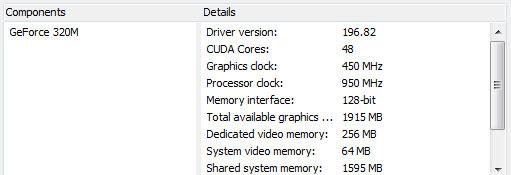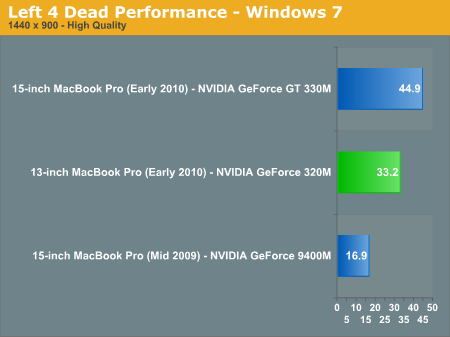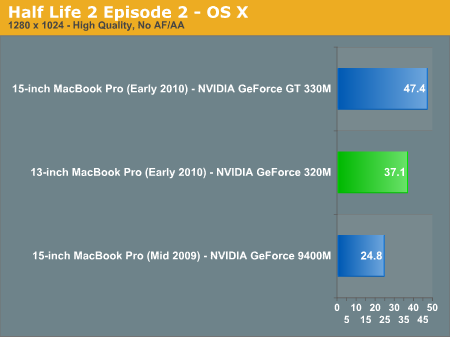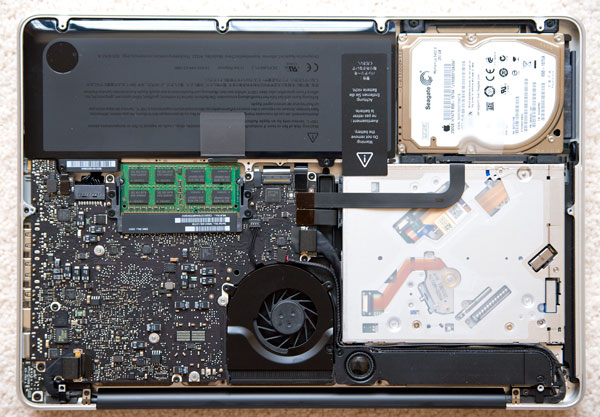Apple's 13-inch MacBook Pro (Early 2010) Reviewed: Shaking the CPU/GPU Balance
by Anand Lal Shimpi on June 9, 2010 12:15 AM EST- Posted in
- Mac
- Apple
- Intel
- MacBook Pro
- NVIDIA
Not Arrandale, but Better Graphics
Apple is up to something. For the past 1.5 years every single Mac has shipped with some form of NVIDIA graphics, standard, regardless of price. These are all G9x based GPUs with full support for OpenCL. From the looks of it, Apple is trying to broaden its install base of OpenCL compliant machines. In preparation for what I'm not really sure, but something is coming.
The unwillingness to ship a Mac without real GPGPU support leads us to the current problem with the 13-inch MacBook Pro. There's not enough motherboard real estate to include an Arrandale Core i3/i5 CPU plus an NVIDIA discrete GPU like Apple does in the new 15 and 17-inch models. Rather than sacrifice the GPU, Apple sacrificed CPU speed.
The new 13-inch MacBook Pro starts with a 2.4GHz Core 2 Duo processor based on the three year old Penryn core. It's an upgrade from the 2.26GHz model that shipped with last year's model, but no where near as fast as the Core i5 you get with the 15-inch MBP.
Apple justifies the mild CPU upgrade by including a much more potent GPU: the GeForce 320M. The 320M has 48 cores up from the 16 that were in last year's GeForce 9400M. Like the 9400M, the 320M has a full fledged chipset to go along with it. A single chip for the CPU and one for the chipset/GPU, that's how Apple is able to keep its current motherboard/chassis design with the upgrade. Something Apple didn't want to sacrifice by going to the Core i5.

Looking at Intel's roadmaps, there are no package shrinks planned for Arrandale throughout 2010. If Apple wants to move the 13-inch platform to a Core i3/i5/i7 it needs to redesign its system to somehow make it fit or pray for a NVIDIA Arrandale chipset.
Is the upgraded NVIDIA GPU worth it? To find out I ran a handful of gaming benchmarks, both under Windows 7/Boot Camp and OS X (thank you Valve). We'll start with World of Warcraft running at 800 x 600:

Performance is much better than last year's GeForce 9400M, you're looking at more than double the frame rate. Our WoW test actually went from choppy to playably smooth on the new 13-inch MacBook Pro compared to last year's 15-inch with a 9400M. The GeForce 320M also offers around 80% of the performance of the GT 330M in the 15-inch. The benefit? You don't have to worry about switching between GPUs, there's only one to deal with in this system.
Next up is Left 4 Dead under Windows 7:

Up the resolution to 1440 x 900 (we had to resort to an external display to get it this high on the 13-inch) and the performance improvement over last year's 9400M remains consistent. The new 13-inch MacBook Pro has roughly twice the gaming performance of the GeForce 9400M found in last year's. At higher resolutions the gap between the 320M and GT 330M widens however. The 320M now offers less than 70% of the performance of the GT 330M. For its native panel resolution, the 13-inch's 320M is sufficient however. Apple usually does a good job of hardware selection.
While Source engine performance under OS X isn't all that great, the new 13-inch MacBook Pro is at least playable in even the most GPU intense games Valve offers:

The performance improvement over the 9400M here isn't as great, but still noticeable. The 320M offers 78% of the performance of the GT 330M. Overall I would call the GPU upgrade the 13-inch MacBook Pro received significant, but it's only something you'll notice if you're a gamer. If you aren't playing 3D games on your notebook, the upgrade is mostly meaningless today.
Looking forward, I suspect that Apple may stick with its GPU strategy for at least one more cycle. While Sandy Bridge (due out in 2011) will have much improved graphics performance, I don't believe it will have much of a compute focus. We may not see that from Intel until Ivy Bridge in 2012 or Haswell in 2013. Apple has been talking to AMD about Llano so that's another potential solution for small form factor Mac notebooks moved forward.











93 Comments
View All Comments
oldbriones - Wednesday, June 9, 2010 - link
Glaringly missing in display evaluation is any mention of the viewing angle. Anandtech probably knows that the supposedly "Pro" models have cheap TN LCD type thus resulting in crappy viewing angles. I expect Anandtech to educate its readers about availability of better screens so that manufacturers will respond to the market demand.Zok - Wednesday, June 9, 2010 - link
Good point, but when was the last time you've seen a laptop not sporting a TN LCD?Penti - Wednesday, June 9, 2010 - link
Only tablet-PCs don't and they are only on IPS-based tech since recently and in smaller sizes, as far as I'm aware of there is no 15" low power laptop panel in existence or being manufactured. They can't use something that aren't manufactured, and a display like that isn't in the catalogs of the Korean and Taiwanese panel manufacturers and are frankly out of most of theirs capability. Many of them simply don't make any IPS screens at all. Haven't seen PVA panels in those sizes and power envelope or anywhere near.IPS screens in devices like iPad was unheard of before LG put one together for Apple and hard to imagine. As netbooks and low cost devices use TN panels and e-readers use reflective technology.
Every photoguy knows the macbooks screens aren't worth a shit and that they need a calibrated external screen for referencing and work. So I hope it doesn't come as a surprise to anybody. The MBP screens aren't worse then any others. But it's still pretty useless for a lot of things. Any way that's what the review of monitors is for. They have done more detailed reviews of laptop screens too, but they only confirm that they are horrible. I'm pretty sure also that the screens for high-end tablet PCs isn't that good when it comes to color accuracy their usage is for viewing angles. And that isn't everything.
Penti - Wednesday, June 9, 2010 - link
And when I say based on IPS (IPS-based) I mean AFFS panels. They exist for up to 14". They are actually 262k color panels, while they have good viewing angles though. LG haven't invented a unique macbook screen yet.BlendMe - Wednesday, June 9, 2010 - link
Now that Apple is shipping the iPad and iPhone 4 with IPS panels it might not take to long till they move the tech up to their MacBook line. The iMac already have it but they're not power limited like laptops.ksherman - Wednesday, June 9, 2010 - link
"Every photoguy knows the macbooks screens aren't worth a shit..."That all depends. if you shoot in AdobeRGB, yeah you would be left wanting. I shoot almost exclusively in sRGB because that's what everyone seems to want anyway. As such, near 80% coverage of the AdobeRGB spectrum works just fine.
The bigger problem is an uncalibrated display. Calibrate the display and it will get you close enough in almost ever situation.
Of course though, it always depends on your medium/use for the pictures. I shoot for newspapers. They compress the details right out of the pictures online and the half-tone process kills and color correction or detail anyway.
If I shot for a magazine, it might be a different story. I'd have a lot more money and probably wouldn't be editing and transmitting from my car more often than not.
Anyway, I love my (first gen) unibody 15" MacBook Pro, but I'm lusting after the matte high-res display and awesome battery life.
bji - Wednesday, June 9, 2010 - link
What an interesting job you must have compared to those of us who sit in front of a computer in a cubicle all day ...rpottol - Monday, June 14, 2010 - link
IPS were dropped from the Thinkpads because they could no longer be obtained in the quantities that they needed them, Apple would need them in far greater quantities (given that they were only on a few high end Thinkpads, as opposed to what apple ships).We may long after them, but for now, we are stuck with the cast offs from the TV market.
oldbriones - Thursday, June 10, 2010 - link
It was only a few years ago (granted that is a long time in tech-years) that there were beautiful high quality IPS LCD options on laptops such as IBM/Lenovo T43, T60, etc. Lately most consumers got seduced into cheap but seriously compromised (display-wise) machines, and then suffer afterward searching for that elusive head and body tilt to view the movie at. Then again, many people probably don't even know what they are missing.Stokestack - Thursday, June 10, 2010 - link
The asinine glossy screen is a much bigger defect. What is with Apple's continued ignorance on this matter? I'm using a MacBook Pro with a glossy screen right now, and it is abysmal in ALL lighting conditions. From a pitch-dark room to a sunny office.To charge extra for a matte option on the other two MBPs is bad enough, but then they don't even offer it on the computer that's most likely to leave the house and be used in a variety of lighting. There's no excuse, because the size of the computer has nothing to do with this feature.
Sad.